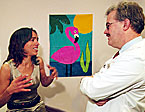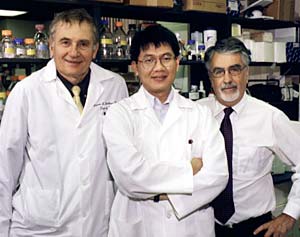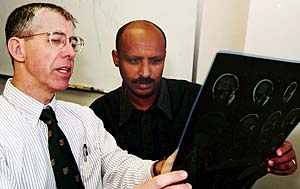


The Cocktail Conundrum
The standard treatment for AIDS is a potent multi-drug “cocktail” that successfully checks this deadly viral assault on the immune system. Unfortunately, it’s getting harder to swallow.

Heidi Beddingfield, infected with HIV for more than 10 years, discusses her health with William G. Powderly, MD, clinical director fo the AIDS Clinical Trials Unit (ACTU) at the School of Medicine.

“...the body takes a series of hits...over the course of
the disease.”
— Kevin E. Yarasheski, PhD


Some of the drugs commonly prescribed as the AIDS “cocktail.”

“HIV is not a death sentence anymore.”
—Pablo
Tebas, MD
![]()
When first diagnosed with HIV in 1990, Heidi Beddingfield was a carefree 18-year-old, still feeling the invincibility of youth. “I expected I only had three years to live, but it didn't bother me,” she says. “After all, what could I do about it?”
She was right—there wasn't much that could be done at the time. The few available drugs could only be expected to control the virus for about a year. Besides—it was too much of a hassle for the teenager to deal with grinding up multiple pills every day and sticking to a strict regimen.
In a way, she was lucky. Beddingfield's virus didn't flare up until December, 1995. Overnight, she went from feeling invincible to becoming incapacitated by a bacterial infection that attacked her brain, a not uncommon consequence of an immune system weakened by HIV. Fortunately, by that time, scientists had just discovered a new way to treat the disease: by combining three classes of medication.
After five weeks on this triple-drug cocktail, Beddingfield's viral count decreased drastically; after a couple more weeks her virus qualified as “undetectable.” Six years later, her AIDS is still under control.
But there's a catch. In 1998, Beddingfield started to dramatically lose weight. Her body is wasting away, and doctors now suspect the very drugs saving her life are to blame.
A Dangerous Pattern Emerges
When the first cocktail component (nucleoside analogs, such as AZT) was introduced in 1987, scientists were optimistic. But patients with human immunodeficiency virus (HIV), the precursor to acquired immunodeficiency syndrome (AIDS), stopped responding to the medication after just one year of continuous use.
In the following years, two new classes of drugs were quickly approved by the FDA: non-nucleoside reverse transcriptase inhibitors and protease inhibitors. By 1995, the FDA recognized that combining drugs from these three classes crippled the virus' ability to replicate. The result: highly active antiretroviral therapy (HAART), commonly known as the AIDS drug cocktail.
Thanks to the cocktail, people with AIDS now are living considerably longer and healthier lives than before. But the treatment falls short of physicians' initial expectations. The new drugs may be able to control the virus, but they cannot eliminate it. Researchers have thus far conceded that patients will have to remain on medication for the rest of their lives. And, as has happened with the first cocktail component when taken alone, continuous long-term use of the cocktail could result in the development of drug-resistant strains of the disease, if patients don't adhere strictly to the drug regimen.

Steven L. Teitelbaum, MD, with fellows Michael Wang, MD, and Patrick Ross, PhD.
The drugs also may not be risk-free, as previously thought. As patients like Heidi Beddingfield live longer with the disease and spend years taking these drugs, new problems arise.
“Not until my body started to change did I really feel all the things AIDS robs you of,” says Beddingfield, “your dignity, your self-esteem, your appearance and your physical well-being.”
It's that last quality—physical well-being—that her School of Medicine physicians are focusing on. For 14 years, the university's AIDS Clinical Trials Unit (ACTU), part of the largest consortium of AIDS research centers in the world, has been at the forefront of developing new therapies. In 1997, experts here and at other centers started to notice a dangerous pattern of metabolic changes, such as insulin resistance and high cholesterol; today, these changes are found in roughly half of all patients on the cocktail. If these effects, collectively termed lipodystrophy, continue to intensify as expected, researchers predict persons taking the cocktail will eventually experience a marked increase in life-threatening complications such as diabetes, heart disease and stroke.
Patients with lipodystrophy exhibit at least two of the disorder's three main symptoms: insulin resistance, the precursor to diabetes; high triglycerides or cholesterol, which often leads to heart disease and stroke; and a unique pattern of fat distribution. Patients with the disease lose fat from their extremities and their faces, and they gain fat inside the abdomen itself, instead of just below the skin surface and outside the abdominal wall, as in normal weight gain.
The exact cause of lipodystrophy is unclear. What is known is that HIV makes copies of itself which then invade other cells. The virus recruits each corrupted cell along the way in a pattern of continuous replication. As patients live longer with the cocktail's help, the virus has more time to wreak havoc. Also, many HIV-positive patients are co-infected with other diseases such as Hepatitis B. As they survive longer, these secondary infections also have more time to affect metabolism.
But neither of these theories fully explains the sudden increased incidence of lipodystrophy noted in the past few years, coincident with introduction of the third cocktail component, protease inhibitors.
“We believe that the body takes a series of hits,” explains Kevin E. Yarasheski, PhD, associate professor of medicine, “and that the toxic effects of the anti-HIV drugs and infection with HIV accumulate over the course of the disease.” Scientists propose that protease inhibitors in and of themselves do not cause lipodystrophy. But, when taken in conjunction with this sequence of “hits,” they may trigger undesirable physical and biochemical changes in the body.
Researchers at the ACTU decided to take action. William G. Powderly, MD, co-director of the division of infectious diseases and professor of medicine, assembled a team led by himself, Yarasheski and Samuel Klein, MD, the Danforth Professor of Medicine and Nutritional Science, to investigate this emerging problem. The team plans to analyze muscle and fat tissue samples from lipodystrophy patients and compare them with samples obtained from HIV-infected individuals who are not experiencing metabolic changes. They also will examine the contribution of protease inhibitors to these metabolic changes by carefully altering the components of the cocktail in certain individuals experiencing side effects.
Further insight into the lipodystrophy phenomenon may provide new hope for patients infected with HIV and for non-infected individuals with diabetes, high cholesterol or triglycerides, or abdominal fat.
“If we determine the mechanisms underlying the cause of lipodystrophy in HIV-infected patients, we may be able to develop specific therapies for these complications or, even better, help to design drugs that target the virus but avoid these effects,” says Powderly. “The other spin-off is that this is a model system for very common disorders, such as diabetes and high cholesterol, in individuals who are not HIV-positive. We can use these new drugs to gain a glimpse of metabolic processes in normal, healthy individuals that we otherwise might not have found.”
Washington University researchers already have made the novel discovery that patients who receive the drug cocktail are more susceptible to bone softening, such as that which occurs in osteoporosis. Steven L. Teitelbaum, MD, the Wilma and Roswell Messing Professor of Pathology, specializes in the basic science aspect of bone research. Already he is using information from the ACTU's clinical research to study the effects of HIV on bone cells in mice.
Living with AIDS
During the first five years of living with her disease, Heidi Beddingfield neglected to take her medications. Even with today's improvements in AIDS therapeutics, she ingests a grueling regimen of 30 pills a day. Imagine how much more difficult it would be to keep up with this rigid schedule for patients who also are developing neurological symptoms such as memory loss or attention difficulties.
Despite treatment advancements, some patients are faced with this added challenge. Within days of being infected with HIV, the virus spreads into the central nervous system (brain and spinal cord) and into peripheral nerves. In fact, it is puzzling that only some patients experience the effects of nervous system damage. By understanding these symptoms and determining how and when they arise, researchers hope to improve their basic understanding of AIDS and to develop new ways to treat the infected nervous systems.

David B. Clifford, MD, left, confers with research fellow Enawgaw Mehari, MD.
Just as in lipodystrophy, some neurological effects of HIV may be exacerbated by the toxicity of medications. For example, peripheral neuropathy—chronic, disabling pain in peripheral nerves such as those in the feet—actually worsens with treatment of the virus and is estimated to affect at least 30 percent of patients with AIDS. In contrast, the incidence of central nervous system disorders has decreased since the cocktail was introduced, from roughly 65 percent to less than 10 percent.
“The numbers are down, but it's still a serious problem,” says David B. Clifford, MD, the Seay Professor of Clinical Neuropharmacology in Neurology and vice chairman of neurology. “Our main concern is what will happen next, because we know this is an area where the virus is just waiting to spring back and where our therapies are incomplete.”
The central nervous system arguably presents the biggest challenge in understanding how to reach the virus and halt its destructive effects. Medications have a difficult time getting into the brain because of its natural protective shield, the blood-brain barrier. Also, scientists suspect that HIV attacks the brain and spinal cord in a slightly different fashion than the rest of the body.
Clifford therefore is examining the cerebrospinal fluid—fluid that fills the spaces around the spinal cord and in the brain—from HIV-positive patients. He plans to measure the activity of the virus in the central nervous system as cognitive performance changes and hopes to determine the effectiveness of HIV medications in penetrating and helping the nervous system.
Another unique challenge is that brain cells are more sensitive to changes in their environment than other cells in the body. According to Clifford, cognitive decline may result from the sheer presence of infected immune cells that release chemicals not normally found in the brain environment. His team currently is testing a promising drug called selegiline that may help protect nerve cells.
“Because we can't yet eradicate the disease, there is a low-grade infection in the brains of all patients with HIV,” says Clifford. “We are concerned that as patients live longer, they may be subject to an accelerated degenerative disease, similar to Alzheimer's.”
Despite these hurdles, one fact remains: These drugs save
lives. According to Pablo Tebas, MD, medical director of the ACTU and
assistant professor of medicine, “HIV is not a death sentence anymore.
There is a trade-off in everything in life, and medicine is no exception.
But the benefits of understanding the side effects of therapy will be
global.” ![]()
|
The School's clinical AIDS care could soon stretch from St. Louis to Ethiopia Washington University School of Medicine not only has one of the leading AIDS research programs, it also serves the St. Louis community through various outreach efforts. One example is the Helena Hatch Special Care Center for women with HIV, which has become a nationally recognized center of excellence for comprehensive HIV care and clinical investigations of HIV among women. Soon, the School of Medicine's influence may reach as far as Africa, where availability of the latest medications and information is still scarce despite the fact that more than 25 million people there are now infected with HIV. David B. Clifford, MD, and his African research fellow, Enawgaw Mehari, MD, recently returned from a trip to Mehari's home country, Ethiopia, where they discussed plans for a clinic at the University of Addis Ababa. With funds from organizations such as the World Bank, the United Nations and the National Institutes of Health, the team hopes to establish a center at the university where they will mentor Ethiopian physicians and establish a basic AIDS therapy program. “We're excited about the possibility of setting up a clinic which will be a practical help to people who are in desperate need,” says Clifford. “Ever the academician, I also am eager to have the opportunity to learn more about this infection in a different cultural population. We're hopeful that it will be a very rewarding project.” |